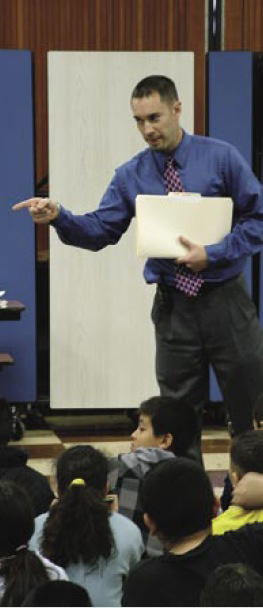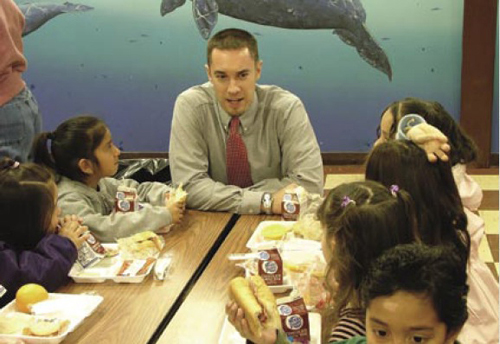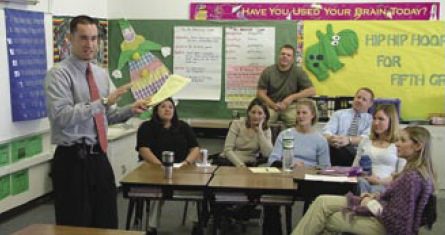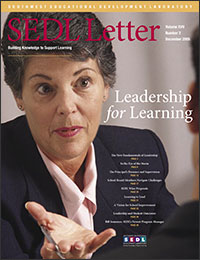Voices from the Field: The Principal's Presence and Supervision to Improve Teaching

A long time ago, in a galaxy far, far away from the heightened accountability standards, increased public scrutiny, and pressure to improve student achievement, the school principal served primarily as a manager and facilitator. Maintaining order and overseeing the operation of the school facility were of primary importance. Meanwhile, the teachers taught and the students learned. Or not.
Now, in the era of accountability, principals face challenges heretofore unseen, with schools facing sanctions for under-performance, with drastic changes in the education landscape of the country, and with the future of our society riding on each educational decision, the school principal forges a path in uncharted territory. There is nothing simple about the most important position in American education. The principal is arguably the single most influential individual in any given school.
The principal of the 21st century has embraced a new role: educational leader. With the growth and achievement of children as the focal point of all practices and decisions, the principal relies almost exclusively on the school’s teachers. And teachers, the principal’s most valuable assets, require and deserve more than management; they need strong relationships, individual attention, consistent support, fair treatment, and accurate feedback. In short, they need active supervision based entirely upon their own and their collective improvement.
The following principles and structures off er some guidelines for exacting a measure of coordination between the work of the school administrator and the growth of today’s teachers. The school principal is key, and these ideas will show how the principal’s presence and supervision can indeed influence and improve teaching.
Be There

Do not mess with the principal. Principal Pete Hall entertains a group of students at Anderson Elementary School, Reno, Nevada.
Perhaps the most elemental component of an achievement-minded educational leader is the most obvious, yet it remains frequently overlooked in the hectic whirlwind we call the principalship. It is presence, physical and otherwise.
The principal’s active, engaged presence yields more dividends than would seem reasonable. To wit:
- Awareness. Here is a defining question: Where is the action, in the office or on the campus grounds? If you answered “the office,” you have a better chance of catching a javelin than you do of being a successful principal. The principal should be where the action is, which is where the students are—in the classrooms, around the campus, on the playground, in the cafeteria, and on the swing set. Only by observing the students in their element can one truly understand their experiences, feel their existence, and know the goings-on of the entire school. And there is no substitute for that knowledge.
- Visibility. A highly visible principal may lose the luster of mystery and intrigue among the constituents—but this is not the CIA. Contrary to conventional wisdom, most people actually enjoy seeing the principal around campus, covering recess duties, walking through classrooms, and loitering in the foyer. Visibility breeds reassurance and familiarity, while at the same time offering a healthy dose of fear and order. It has been said that when a principal walks into a room, it has the same effect as seeing a state trooper pulling onto the highway—the students straighten up and “take their foot off the gas,” even if they weren’t speeding (er, misbehaving).
- Clarity. As we know from science, increased blood flow and oxygen improves brain functioning. So why stay cooped up in an office all day and diminish the brain’s capacity? Walk briskly down every hallway, check the perimeter fences, kick a soccer ball with a group of second-graders during recess, or scan the entire courtyard for loose change. Move about, and do so frequently. Put ludicrous numbers on your hip pedometer, burn some calories, and clarify your thinking. All the while you will be increasing your awareness and your visibility, so the physical boost of daily exercise is an added bonus.
- Relationships. Naturally, when a principal is on the grounds for a good portion of the school day, the students, staff, and local wildlife will begin to look forward to those daily interactions, no matter how brief. Similarly, the principal will get to know the members of the school community and learn where the hot spots are, which students need a reassuring comment or high-five, and where to intercept a teacher for a brief chat. This is also an opportunity for teachers to snag the principal and ask that just can’t-wait question, to tell about last weekend’s special event, or to check on the status of the Red Sox bullpen. No matter the exact locale, and no matter the content, a present principal is one with whom all members of the school community can build a relationship. And relationships, when dealing with a profession that is (or should be) 98 percent human interactions, are of the utmost importance.
These are but a sampling of the benefits drawn by an active, present principal. Doubtlessly there are many, many more, each carrying significance that extends into many aspects of the principal’s role as educational leader. The key is this: high visibility leads to familiarity and trust, which is essential when we cross the bridge into the land of direct teacher supervision.

Be there or be square. The lunchroom is a great place to find out what is going on at your school as principal Hall finds out.
Goal-setting and Walk-throughs
Early in the school year, the principal should meet with each teacher on staff to discuss that individual’s goals for the year. Ideally, those goals will match rather closely with the agreed-upon schoolwide focus objectives, but there will inevitably be some distinct variety between Mrs. Orcutt’s goals and Mr. McHenry’s goals, based on their training, experience, grade level, and psyche. Nevertheless, when the principal and teacher sit down to discuss the areas of emphasis for instruction, management, organization, assessment, preparation, collaboration, or whatever the emphasis may be, it is important that each goal has one major characteristic: it is meaningful and relevant to the teacher in question.
Many goals are admirable but fail this test (i.e., a reading specialist desires to clear the clutter off her desk, a classroom teacher wishes to become more physically fit, a special education teacher strives to be off campus by 3:15 every day). A meaningful goal is one that the teacher will inherently wish to confront and work on; relevance speaks to the degree to which the goal agrees with the principal and vice versa.
Once a meaningful and relevant goal is established and growth objectives are outlined (growth objectives are smaller, more detailed benchmarks that are easily observed to help the teacher progress toward the goal), the teacher is ready to teach and the principal can prepare to engage in the true art of educational leadership, manifested in a beautiful vehicle called the walk-through.
What is a walk-through? In a nutshell, a walk-through is a procedure undertaken by a principal involving a walk through the classrooms, buildings, and hallways of a school. Formalized in recent years, the walk-through process transcends traditional drive-by, peek-in tours conducted by supervisors by making principals and teachers aware of agreed-upon “look-fors.” These specific items are the vital components the principal looks for while in the throes of a walk-through. This focuses the administrator on noticing improvements in the essential elements of teaching and learning.
Look-fors can be established on an individualized basis (the principal expects to see certain learning activities when entering Mrs. Orcutt’s classroom based upon her individual annual goals) or on a staffwide scale (the principal expects to note that every teacher in the school utilizes a word-wall with high-frequency and thematic-based vocabulary based upon schoolwide instructional emphasis). In the spirit of continuous instructional improvement, the principal can now embark upon the walk-through process.
As outlined by Rick Harris, director of the Principals’ Academy of the Washoe County School District in Reno, Nevada, any given walk-through can last from 3–15 minutes, which is long enough for the administrator to get a feel for the classroom environment and learning activities but not so long as to begin to grow roots. Once inside a classroom, the principal seeks an unobtrusive spot to roost (depending on the students’ reception, this can be at the back of the room or at the teacher’s desk—the more frequently the walk-through process is used, the easier it will become to sit with a group of students on the floor or at a table in order to get the participant’s point of view while maintaining discretion). Scanning for look-fors and making note of aspects related to the teacher’s individual annual goals, the principal records items or activities worthy of mentioning, such as answers to the following questions:
- What are the teacher and students engaged in? What is their level of engagement?
- What is the format of the lesson (whole-class instruction, small-group work, individual study, etc.)?
- What higher-order thinking processes are the students asked to undertake?
- What is the goal of the lesson, and is it clear to determine?
- Do the students know what the ultimate learning outcome will be?
- What instructional aids is the teacher employing? Are they appropriate?
- What background knowledge must the students have to be successful at this task?
- How will the teacher assess student progress at the completion of the lesson?
These questions, in addition to more precise probes more pertinent to the individual teacher, school, class, and/or lesson involved, should guide the principal in providing immediate and appropriate feedback. Using a simple form with duplicate-NCR paper, the principal can record observations, offer suggestions, share praise, and pose queries to the teacher. Upon leaving the classroom, the principal gives the teacher one copy of the form and takes the other for reference and/or record-keeping.
The walk-through form, like a love-note passed across the aisle in a seventh-grade English class, is a highly underrated component of the walk-through process. Teachers appreciate immediate feedback, whether it is positive, negative, or neutral. There is not always time—in fact, there is rarely time—to engage in a productive discussion with every teacher every day. This tool, however, provides an avenue to open discourse without the burden of matching schedules. The teacher can respond to the walk-through note, ignore it, accept the contents, refute it, or seek clarification at a (later) time that suits everyone involved.
Suggestions from administrators who have utilized the walk-through process are summarized as follows:
- Begin with several all-positive, all-supportive notes the first few weeks. This establishes the walk-through process and the written notes as a nonthreatening, teaching-and-learning-focused tool for improvement.
- Avoid generalizations and assumptions. As in all comments and feedback given to professionals, base the written note on actual observations and indisputable facts. When in doubt, leave a question (“Do your students always sing ‘Down by the Bay’ when they sharpen their pencils?”) rather than a judgment (“Your students make too much noise while working on nonacademic tasks”).
- Have a focus. Whether it is a list of look-fors or work related to a teacher’s annual goals, have a purpose for the walk-through. Aimless visits can lead to rambling, irrelevant feedback, which nobody really values. Refer to the goals and/or look-fors in the written notes.
Time management will play a role in the successful implementation of classroom walk-throughs as effective walk-throughs with meaningful feedback take time. Dr. Paul Rozier, the superintendent of schools for the Kennewick Public Schools in Kennewick, Washington, led every administrator (building-level and district-level) in making a “2/10 pledge”—to be in the school buildings, walking through classrooms, for 2 hours per day or 10 hours per week. Such was their level of commitment, and it served as a powerful statement as to the importance of the walk-through process.
A realistic goal may be for a principal to conduct five high-quality walk-throughs per day, thereby ensuring a certain level of precise, individualized feedback to each teacher over the course of a week or 2, depending on the size of the school. In addition to the daily rounds of ducking into each classroom, this walk-through goal should provide enough impetus to get into the classrooms without setting an unreasonable expectation for consumed time.
Walk-throughs, needless to say, assist tremendously in the formal evaluation process for each and every teacher. The process gives the principal ample opportunities to observe authentic instruction in every classroom. It also provides a framework for offering precise, specific feedback and professional development to the teacher when, how, and as often as it is needed or requested. Often we wait too long to provide professional assistance, or we attempt to box it up during workshops for the entire staff when only a handful truly need that certain knowledge boost or intervention.
In short, the entire supervision and evaluation aspect of the principalship should be designed around the unwavering support and development of every individual teacher on staff. Individually. Principals can tell their teachers, “I am here to help you grow and improve as much as I can. I will not treat you all equally, for you are all unique carbon life forms and you all have different skills, strategies, strengths, and weaknesses. However, I will treat you all fairly.” That is an important distinction to make, for as we ask our teachers to differentiate instruction for each of their students, we too should differentiate our supervision and evaluation of teachers.
Conclusion
The school site administrator, with special emphasis on the building principal, has a remarkable responsibility to assume the role of educational leader. Establishing a presence as an active, involved member of the daily school routines can help build relationships among the key stakeholders of the school community. Benefiting from those strong relationships with staff members, the principal’s supervision and evaluation of teachers becomes a valuable process when using appropriate goal-setting and walk-through techniques. In this way, the principal can have a running head start in the race to improve instruction, increase student achievement, and make a difference in the world.

The world according to Hall: Teachers deserve more than management. They need strong relationships, individual attention, and consistent support.
Pete Hall is principal of Anderson Elementary School, in Reno, Nevada. He is the author of The First-Year Principal, published by Rowman & Littlefield.
Next Article: Making the Grade: School Board Members Navigate Education Challenges

